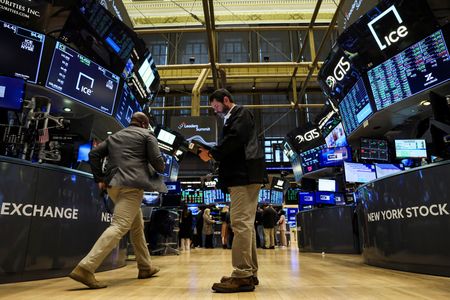A look at the day ahead in U.S. and global markets from Mike Dolan.
A potentially pivotal week for U.S. monetary policy has been given a new twist from fresh ‘terminal rate’ speculation, with worrying world growth signals from China and global inflation fears stoked by higher grain prices.
Despite some share-shocking earnings from U.S. mega caps, the broader stock market was buoyed last week by hopes this week’s Federal Reserve policy decision would signal a downshift in the size of rate hikes from a fourth straight 75 basis-point rise this Wednesday to a half-point move in December.
But separate weekend reports indicated this may be accompanied by guidance toward a higher peak rate of 5%, with Fed futures for May now just a whisker below that level and Goldman Sachs reported to have upped its terminal rate forecast by a quarter point to 5% by March.
That lifted short and long-term Treasury yields on Monday, with the dollar rising again across the board.
U.S. stock futures were in the red along with European bourses and China’s main indices, with Hong Kong clocking its biggest monthly loss in 14 years to its lowest since 2009, amid further dour Chinese economic readings.
The yuan fell again, registering its 8th straight monthly loss and the longest such streak since 1994.
China’s factory and services activity unexpectedly fell in October, weighed by softening global demand and strict domestic COVID-19 curbs. The gloom knocked oil prices by more than 1%.
Production of Apple’s iPhones, meantime, could slump by as much as 30% at one of the world’s biggest factories next month due to tightening curbs. Manufacturer Foxconn is working to boost production at another factory in Shenzhen city to make up for the shortfall.
But world inflation fears were stoked by rising food prices after Russia at the weekend backtracked from a U.N.-brokered deal to export Black Sea grains. Chicago wheat futures jumped almost 6% on Monday and corn rose more than 2%.
Brazilian stocks traded overseas fell on Monday after news that leftist leader Luiz Inacio Lula da Silva narrowly defeated President Jair Bolsonaro in a runoff election. Markets are now looking for confirmation of Bolsonaro’s concession and indications on who Lula will appoint to his cabinet in key posts such as finance.
In banking, Credit Suisse on Monday unveiled details of its plan to raise 4 billion Swiss francs ($4.01 billion) from investors to tackle the biggest crisis in its 166-year history.
And the Swiss National Bank said it lost 142.2 billion Swiss francs ($142.6 billion) in the first nine months of 2022 as rising interest rates and the stronger franc slashed the value of its foreign investments.
Key developments that should provide more direction to U.S. markets later on Monday:
* Chicago Oct Purchasing Managers Index, Dallas Fed Oct manufacturing index
* U.S. Corporate Earnings: Loews, Global Payments, Caesars Entertainment etc
Graphic: China’s factory activity unexpectedly falls in October – https://graphics.reuters.com/CHINA-ECONOMY/PMI/dwvkdgjnmpm/chart.png
Graphic: Rising grain futures – https://graphics.reuters.com/GLOBAL-GRAINS/movakmygeva/chart.png
Graphic: Brazil Election Lula wins Brazilian election – https://graphics.reuters.com/BRAZIL-ELECTION/myvmomjrzvr/graphic.jpg
(By Mike Dolan, editing by John Stonestreet; [email protected]. Twitter: @reutersMikeD)

